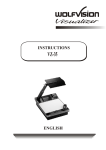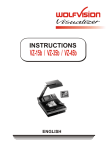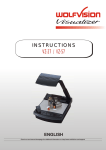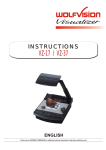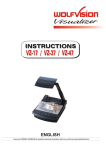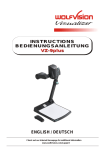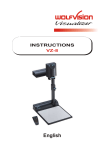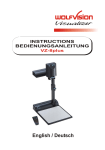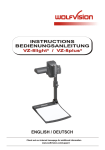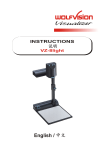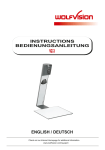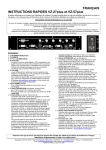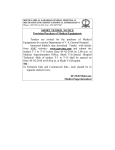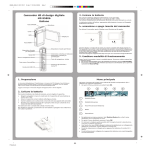Download English PDF - WolfVision
Transcript
R INSTRUCTIONS VZ-15 ENGLISH PRECAUTIONS Make sure that sufficient air circulation for cooling the unit is possible (ventilation slots on the left and right side of the unit) If the Visualizer is not used for a long time turn off the main power switch (#34)! If there is any abnormality (abnormal noise, smell, smoke etc.) turn the power off immediately and contact your Visualizer dealer! USE THIS MACHINE ONLY WITH THE CORRECT VOLTAGE AS SHOWN ON THE TYPLABEL ! Do not use a damaged power cord. This may cause short circuits or electrical shocks! Do not modify the Visualizer or operate it without the cover panel firmly in place, to prevent danger! DO NOT EXPOSE THE UNIT TO EXTREME HEAT OR MOISTURE ! Do not expose the Visualizer to water, metallic objects or any flammable material. Do not place liquids or wet objects on the working surface! Put them in front of or behind the unit and use it as a camera. If you work with wet hands, cover the remote control with plastic wrap! DO NOT CARRY THE VISUALIZER HOLDING IT ONLY BY ITS MIRROR ARM (#1) ! DURING TRANSPORTATION PROTECT THE UNIT FROM EXCESSIVE SHOCKS ! Avoid installing the Visualizer in environments where there are radiations. Avoid installing the Visualizer in locations exposed to strong magnetic fields or electrical currents. This could cause monitor image distortion or even damage to the CCD camera. 2 ENGLISH Contents: Precautions Description of the Wolfvision Visualizer How the Visualizer works Basic preparations Working with the Wolfvision Visualizer Working on the working surface Working outside the working surface / Scanning slides Autoiris / Manual Iris Reflections / Glare Lighting Preset functions Switchable outputs Read-in device for computers Connecting a number of monitors Lightboxes (Bottom light) Using a video printer Video recording Switching to playback of a video recorder Scanning slides Lamp changer Maintenance Exchanging lamps Thermostat Exchanging a fuse Infrared remote control Changing the frequency of the IR-control Transportation Maintenance / Mirror cleaning Specifications Connections Troubleshooting Genlock operation (general view on page 15) Page 2 Page 4-5 Page 5 Page 5 Page 6-10 Page 6 Page 6 Page 6 Page 7 IMPORTANT ! Page 7 Page 7 Page 8 Page 8 Page 8 Page 8 Page 9 Page 9 Page 9 Page 10 Page 10 Page 10-11 Page 10 Page 11 Page 11 Page 11 Page 12 Page 12 IMPORTANT ! Page 12 IMPORTANT ! Page 13 Page 14 Page 14-15 Special instructions manual Copyright: Wolf Vision GmbH & Co KG, Vlbg. Wirtschaftspark, A-6840 Götzis, Austria, Tel. ++43/5523/52250-0, Fax. ++43/5523/52249 The Wolfvision Visualizer VZ-15 E/U/UE/N was developed and designed by WOLFVISION in Austria. It is "MADE IN AUSTRIA" Patents (examples): US 5027219, FRG 3833908, CH 678576 Printed in Austria Design and specifications subject to change! 3 September 1996 10 1 4 3 2 13 11 6 9 5 14 #1 Arm with pneumatic damper #2 Mirror system #3 Control panel #4 Connections (on the back) #5 Working plate (black/white) #6 Air extraction #7 Ventilation #8 Lamp changer (see page 10) #9 Lamp exchange cover #10 Reflector head #11 Release button for the arm #13 Sensor for infrared remote control #14 Infrared remote control 8 7 CONTROL PANEL #15 ZOOM tele #16 ZOOM wide #17 FOKUS + #18 FOKUS #19 Manual IRIS dark #20 Manual IRIS bright #21 IMAGE (=switchable outputs) off #22 IMAGE (=switchable outputs) on #23 LIGHT off #24 LIGHT on #25 PRESET 1 (see page7) #26 PRESET 2 (see page 7) #27 POWER off #28 POWER on #29 LED light for Power off (red) #30 LED light for Power on (green) R 15 ZOOM 16 17 FOCUS 18 19 IRIS 20 off 21 IMAGE 22 off 23 LIGHT on 24 on 2 25 PRESET 26 1 off 27 POWER 28 on 30 29 Serial 38 Mains Sync in 33 Parallel 39 34 Fuse 35 36 Preview Composite 31 Y/C 32 37 4 CONNECTIONS #31 Preview video output #32 Composite video output (switchable) #33 External Sync Input (see spezial instruction manual) #34 Main power switch #35 Fuse (see page 11) #36 Power connection #37 Y/C (S-VHS) output (switchable) #38 Serial port for controlling the VZ-15 #39 Parallel port for controlling the VZ-15 HOW THE VISUALIZER WORKS A light projector (b) inside the Wolfvision Visualizer projects the light via a mirror inside the unit and a mirror on the reflector head onto the working surface. The video camera (a) inside the unit scans the picture where the light falls. b The optics of the camera and the light projector are synchronized. This means that when the size of recording area is increased or decreased with the ZOOM-keys (#15,#16), the size of the illuminated area on the working surface is also increased or decreased. a Thus the illuminated area on the working surface always indicates where the camera scans the picture. (In fact, the scanned area is fractionally smaller than the light field.) BASIC PREPARATIONS 1. Press the release button 2. Pull arm upwards 1. Press the release for the arm (#11) and simultaneously pull the arm upward. Make sure that the arm is extended to its full length. 2. Connect the power cable to the unit (#36) and plug it in. 3. Connect a control monitor (if required) to the Preview video output (#31). 4. Connect a large viewing monitor or a video projector to the Composite video output (#32), the Y/C output (#37) or the RGBS output (#40). These outputs can be switched on and off with the IMAGE keys (#21,#22) of the control panel. For live image projection we highly reccomend using the Y/C output (#37). The picture quality (especially the resolution) is much better than with the Composite video output (#32). 5. Turn the main power switch (#34, on the back of the unit) to "I". The red power indicator (#29) on the control panel indicates that power is supplied. 6. Press the POWER on key (#28) on the control panel. The Visualizer now runs the "factory setup" (=automatic focusing of an A5 format on the working surface) during which the green LED light (#30) is flashing. As soon as the green LED light stays illuminated you can start working with the Visualizer. 5 WORKING ON THE WORKING SURFACE 1. Place your subject material on the working surface. For background use either the white side or the black side of the working plate. For some objects the best presentation can be made with colored background. 2. Tilt the reflector head (#10) so that the object is illuminated. TV-Monitor Video projector DO NOT TOUCH THE MIRROR, AS FINGERPRINTS CAUSE BRIGHT AND HAZY SPOTS ON THE PICTURE ! ALWAYS KEEP THE MIRROR CLEAN ! CAUTION: SENSITIVE FRONT COATED MIRROR! 3. Select the enlargement required with the ZOOM keys (#15,#16) on the control panel or the infrared remote control. 4. Adjust the sharpness with the FOCUS keys (#17,#18) on the control panel or the infrared remote control. WORKING OUTSIDE THE WORKING SURFACE For showing 3-dimensional objects with the Wolfvision-Visualizer, just place them on the working surface and adjust ZOOM and FOCUS (as mentioned). Due to a special Wolfvision lens the object can be up to 9.7" (25 cm) in height. If the object is to big for the working surface or if you want to show it from the side just place it behind or in front of the unit and tilt the reflector head. In this way it is also possible to make recordings of subjects in the room or surrounding area, as with a video camera by just tilting the reflector head. Due to the great focal range it is possible to show details even from a great distance to the unit. If you want to record people you should turn off the light with the LIGHT off key (#23), so that they are not dazzled. AUTOIRIS / MANUAL IRIS The Wolfvision Visualizer is equipped with autoiris. That means that the brightness of the camera image adjusts automatically. Using the IRIS keys (#19,#20) on the control panel or the remote control the autoiris function is switched off. In this mode the Iris can be adjusted manually. When using the ZOOM keys (#15,#16) on the control panel or the remote control the autoiris function is switched on again 6 IMPORTANT REFLECTIONS / GLARE Reflections can appear only in the bottom half of the working surface, where the light is reflected directly into the camera. In this case, move the object upwards and tilt the reflector head slightly. If this is not possbile (e.g. with very big objects), pull the working plate to the front of the unit (as shown below) and tilt the reflector head accordingly. As the working plate is magnetic, it will stick to the unit. Reflection: No reflection: No reflection: Working plate (#5) Light reflected directly into camera Light reflected to the outside Light reflected to the outside Please make sure that reflections are not caused by room light ! LIGHTING The lighting system is fixed for working on the working surface. Because of the oblique mounting of the camera and the light projector of the Visualizer the light-field shifts to the left when the distance between the Visualizer and the scanned object is increased. This means that the light field no longer exactly shows the recorded area. The edges of the light field may also be unsharp. In this case switch off the Visualizers light with the LIGHT off key (#23) and work with room light. 2 PRESET FUNCTION PRESET 1 The Wolfvision Visualizer VZ-15 offers the possibility of programming two presets for the functions Zoom, Focus, Iris, Light and Image. They can be recalled with the PRESET 1 (#25) and PRESET 2 (#26) key. This function is very useful for example if a user requires one preset for papers on the working surface and one preset for an object placed in front of the unit. During his presentation the user just has to press the PRESET 1 or PRESET 2 key when he changes from one object to the other. While the VZ-15 is adjusting the preset position the green LED light (#28) is flashing. For programming a preset just adjust Zoom, Focus, Iris, Light and Image as required and simultaneously press the PRESET 1 or the PRESET 2 key together with the Image on key (#22)). PLEASE NOTE: Always press the Image on key before the PRESET key! Image on + Preset 1 or: Image on + Preset 2 Factory setup: When using the POWER on key (#28) the unit is adjusting the "Factory Setup" (=Zoom and Focus on an A5 format on the working surface) 7 off SWITCHABLE OUTPUTS IMAGE on The Composite video output (#32) and the Y/C output (#37) of the Visualizer are switchable. Use the IMAGE keys (#21,#22) on the control panel or the remote control to switch the signal supplied from these outputs on and off. Independently a video signal is always supplied to the Preview video output (#31). This output can be used for a control monitor. A constant sync signal is supplied to all switchable outputs (even in the image off mode) eliminating monitor image distortions when switching. READ-IN DEVICE FOR COMPUTERS The Wolfvision Visualizer is perfectly suited for working as a 3-D scanner for computers equipped with a Grabber Card. A Grabber Card can be used to digitize a video signal, in order to store and process single pictures on a computer. Therefore just connect the Composite video output (#32) or the Y/C output (#37) of the Visualizer to the according input of your computers Grabber Card. in in out in out in out out CONNECTING A NUMBER OF MONITORS Connect a control monitor to the Preview video output (#31) of the Wolfvision Visualizer. Connect additional monitors to the Composite video output (#32) or the Y/C output (#37) of the Visualizer by looping them through the inputs and outputs of each monitor (as shown above). In this way a number of monitors can be connected. However if the signal is looped through a lot of monitors a video signal amplifier should be used in order to achieve equivalent picture quality on all monitors. The number of monitors throught which the signal can be looped without a signal amplifier depends on the type of monitor and on the cable lenght. OPTIONAL LIGHTBOXES (Bottom light) While working with one of Wolfvisions optional lightboxes, the light of the Visualizer has to be switched off - in order to prevent reflections !!! Switch off the light of the Visualizer with the Light off key (#23) and switch on the light of the lightbox. Optional lightboxes are available from Wolfvision in 3 different sizes. These lightboxes improve the quality of transparencies, X-rays and slides. 8 USING A VIDEO PRINTER The Wolfvision Visualizer can also be used for image capture with a video printer. In this manner single pictures of papers and objects can be made quickly. The lighting and focus problems are eliminated by the Visualizers superb light and scan system. Just connect the Composite video output (#32) or the Y/C output (#37) of the Visualizer to the according video input of the video printer. Connect a control monitor to the video output of the video printer and (if required) a second control monitor to the Preview video output (#31) of the Visualizer. A video recorder can be connected to the Wolfvision Visualizer, so that recordings on video tape can be made. Simply connect the Composite video output (#32) or the Y/C output (#37) of the Visualizer to the according input of your video recorder. When using a S-VHS or Hi-8 video recorder use the Y/C output in order to archive the best picture quality video / Y/C in video / Y/C in video / Y/C out video / Y/C out VIDEO RECORDING VCR "stop" Connect a control monitor to the output of the video recorder SWITCHING TO PLAYBACK OF A VIDEO RECORDER If you want to mix your presentation with the Wolfvision Visualizer with playback of a video tape, connect the Visualizer, the video recorder and the monitor (or video projector) as follows: Connect the Composite video output (#32) or the Y/C output (#37) of the Visualizer to the according input of the video recorder. Connect the video or Y/C output of the video recorder with the audiences monitor or video projector. Adjust the video recorder so that the picture of the Visualizer will be shown. When the video recorder is switched to play the Visualizers picture will be interrupted by the picture of the video recorder. Switch the video recorder to stop and the picture of the Visualizer will reappear on the monitor or video projector. 9 SCANNING SLIDES Slide projector Visualizer The Wolfvision Visualizer together with one or more slide projectors allows easy scanning of individual slides or even whole slide shows (with cross fading). Just project the slides onto a screen (or another white surface), switch off the Visualizers light with the LIGHT off key (#23) and tilt the reflector head to scan the slides (as shown on the left). In this way it is also possible to zoom in on details in a slide LAMP CHANGER 8 The Wolfvision Visualizer is fitted with a lamp changer. If one lamp fails, there is no need to replace it immediately. Just turn the switch of the lamp changer (#8) on the front side of the machine to the locked position. The spare lamp is now employed. Thus there is no need to exchange a lamp during a presentation. The red light above the lamp changer switch illuminates to indicate that the spare lamp (=the left lamp) is employed. This acts as a reminder to exchange the other lamp (=the right lamp) for a new one when next convenient. EXCHANGING LAMPS Viewed from above: 1. Press to the 2. Tilt forwards right 1. 2. 3. 4. Disconnect the power cord! Remove the working plate (#5) Remove the lamp exchange cover (#9) Press the retaining spring (A) on the right side and tilt the black metal plate (B) 5. Tilt the lamp holder 6. Change the lamp A B left lamp Before changing the lamp allow it to cool or use a cloth to avoid finger burning! When pressing a new lamp into the socket use a cloth to prevent fingerprints on the lamp! right lamp Only use 24 V/150 W halogen lamps (cap: G 6,35), types: Philips 7158, Osram 64640 Ansi FCS etc. 7. Return the metal plate and the lamp holder to their original positions 8. Close the lamp exchange slot 9. Reconnect the power cord and turn the main power switch (#34) to "I" 10.Turn the lamp changer switch (#8) to the left so that the right lamp is used. If the lamp changer is turned to the right the red warning light for the spare lamp illuminates even with a new spare lamp. 10 THERMOSTAT If the unit gets too hot (when ventilation or air extraction are covered) a built in thermostat may switch off the light of the Visualizer. Lay open the ventilation and the air extraction and allow it to cool. EXCHANGING A FUSE Before changing a fuse disconnect the power cable. The fuse (#35) is situated behind a small lid between the power socket and the main power switch. It can easily be opened with a small screwdriver etc. The left fuse has to be exchanged. The right fuse is a spare fuse. Please make sure that the fuse is put in the right way round (An arrow on the socket indicates the right direction of the fuse) Power source: Type of fuse: 220V/240V T 1,6 A 100V/110V/120V T4A CAUTION: Only use the proper fuses with the right specifications! Change the fuse for a new one and switch the unit on again. If the fuse fails again contact your Visualizer dealer! INFRARED REMOTE CONTROL For controlling the Wolfvision Visualizer with the infrared remote control aim the remote control at the Visualizer and press the required key. Please note that an infrared remote control can only be used up to a certain distance to the unit. Objects situated between the Visualizer and the infrared remote control and a weak battery may interfere the reception. If the Visualizer can only be controlled from a close distance or if it cannot be controlled at all with the infrared remote control you may have to change the battery. Open the cover of the remote control (as shown on the drawing) with a flat object (for example a screwdriver) and replace the 9 V battery with a new one. 11 Changing the frequency of the IR-control: If a user works with two Wolfvision Visualizers and wants to control them both individually with their infrared remote controls, he has the possibility of changing the frequency on one of the units. For switching one Visualizer and its remote control to the second frequency just use the red switch besides the battery of the remote control and simultaneously press the Save key on the camera control panel (#12) and IMAGE on key (#22) on the main control panel of the Visualizer. IMPORTANT TRANSPORTATION For transportation press the release button for the arm (#11) and at the same time push the arm down to the front of the unit. x Do NOT push this way ! 2. P ThUSH is w a y 1. PRESS here DO NOT TRY TO PUSH DOWN THE ARM WITHOUT PRESSING THE RELEASE BUTTON FOR THE ARM! During transportation put a soft material (like paper) between the mirror and the working surface - in order to prevent damage to the mirror ! The arm is equipped with a pneumatic damper, which makes the arm set-up easy and holds it stable when working with the unit. MAINTENANCE IMPORTANT Please note that dust on the mirror inside the unit has little effect on the picture quality (as it is out of focal range). However the mirror on the reflector head (#10) always has to be kept clean! Mirror: For cleaning the mirror on the arm (#10), wipe it gently with a soft (!) and lint-free tissue (no paper !). Normal dry cleaning should be sufficient (If not, use a special optical cleaner only!) CAUTION: Sensitive front coated mirror! Move the tissue in vertical direction only ! (Horizontal scratches would cause ugly reflections) Avoid high pressure ! DO NOT USE ORDINARY GLASS CLEANER OR ALCOHOL - THE RESULT WOULD BE A SLIGHTLY BLUE MIRROR SURFACE ! The glass covering the mirror inside the unit should also be kept clean. Cabinet: Clean the cabinet by gently wiping it with a soft cloth. Never use strong cleaning agents such as benzine or alcohol! 12 SPECIFICATIONS PICK-UP ELEMENT: System: Effective pixels: Horizontal resolution: Depth of focus: White balance: Iris: Gain control: Optics: Color system: REFLECTOR HEAD: Head rotation: Mirror system: Format on working surface: Format projecting into space: OPERATION: Infrared remote control: Control panel:functions: Programmable presets: Auto preset (factory setup): LIGHTING ELEMENT: Lens light: Light source: Spare lamp: CONNECTIONS: Y/C-output (7-pin connector): 1/2" interline transfer CCD 752 x 582 = PAL (VZ-15E), 768 x 494 = NTSC (VZ-15U/VZ-15UE/VZ-15N) > 460 TV lines Tele: 2.7" (70mm), Wide: 9.7" (250mm) automatic automatic / manual automatic 8.5 x telezoom 20 - 170 mm, f=2.0 (no close up adapter lens) PAL (VZ-15E) or NTSC (VZ-15U/VZ-15UE/VZ-15N) 360 degrees, reflector arm with pneumatic damper, transport or operation positions 2 front coated mirrors (inside the unit and on the reflector head) (On units with serial numer lower than 153468 the mirror on the reflector head was back coated) height up to 9.7" (250mm), width 1.4" to 10.5" (36 to 270mm), length 1.6" to 14" (42 to 360mm) length x width x height 0 to eternity functions: zoom, focus, iris, image zoom, focus, iris, image, light, power preset 1, preset 2 zoom, focus, iris (automatic or manual preset), light, image when pressing the power on button: zoom, focus, iris and light automatically adjusts to a A5 format on the working surface 8.5 x power zoom, electronically synchronized with camera lens 24 V/150 W halogen-lamp, lamp cap G 6.35 (=Philips 7158, Osram 64640, Ansi FCS etc.) 4000 lux in tele position built in lamp changer with LED Preview video output: Composite video output: Sync input: Sync system: Parallel port: Serial port: Y-Signal: 1 Vpp, 75 ohm, C-Signal: 0.3 Vpp (burst level) 75 ohm, (switchable) VBS 1.0 Vpp 75 ohm, BNC connector VBS 1.0 Vpp 75 ohm, BNC connector (switchable) VBS 1.0 Vpp 75 ohm or black burst signal, BNC connector internal and external, horizontal (H) phase and subcarrier (SC) adjustable 25 pin D-Sub connector, 24 V, for external wired remote control 9 pin D-Sub connector, possible configurations: RS 232, (optional: RS 422/485) DIMENSIONS AND WEIGHT: Height folded: Height ready for use: Length x width: Working surface: Weight: 6 3/4" (176 mm) 26 3/4" (690 mm) 23 1/2" x 17 3/4" (598 x 450 mm) 17" x 13 1/2" (431 x 341 mm) 37 lbs (17kg) GENERAL SPECIFICATIONS: Power source: Power consumption: 100-120 / 220-240 V AC, 50/60 Hz max. 230 W SCOPE OF SUPPLY: Power cable Video cable BNC Video cable Y/C (7 pin to 4 pin) BNC/RCA adapter User manual Infrared remote control Specifications subject to change! 13 CONNECTORS Y/C cable cable (7-pin to 4-pin): 5 7 3 4 1 2 (connectors viewd from front side) 1. Y-signal 2. Y-ground 5. C-signal 6. C-ground 3, 4 and 7 not connected 3. 1. 4. 2. Y-signal Y-ground C-signal C-ground Parallel port: (25-pin D-Sub, 24 V) 1 2 3 4 5 6 7 8 9 10 11 12 13 14 15 16 17 18 19 20 21 22 23 24 25 (male - front side) 1. 2. 3. 4. 5. 6. 7. 8. 9. Serial port (9-pin D-Sub) Function: 6 1 2 4 3 Image on Iris open Focus plus Zoom far Power on Preset 1 Light on - 10. 11. 12. 13. 14. 15. 16. 17. 18. GND Image off Iris close Focus minus Zoom near Power off 19. 20. 21. 22. 23. 24. 25. Preset 2 Light off - Image on Iris open Focus plus Zoom wide Image off Iris close Focus minus Zoom near Power on Power off Preset 1 Preset 2 Light on Light off Save preset 1 Save preset 2 Switch IR-mode A/B Preset max. wide Preset A4 Preset A5 Preset A6 Preset A7 Preset A8 Preset max. tele ASCII-Code : 192 193 194 195 196 197 198 199 200 201 202 203 204 205 216 217 221 229 * 230 * 231 * 232 * 233 * 234 * 235 * * = these functions are only available on Visualizers with serial number 153200 and higher Please note that ASCII-Codes must be sent as one byte. (e.g. "199" and not "1" + "1" + "9") Serial port: (9-pin D-Sub) (male - front side) Pins: 2: RX, 3: TX, 5: GND, 7: RTS, 8: CTS Baud rate: 19200, databits: 8, stopbit: 1, parity: no Between sending codes should be a break of 250ms minimum ! TROUBLESHOOTING Symptoms: Check points: No power - Is a power cord connected? - Is the main power switch (# 34, on the back of the unit) switched to "I"? - Check fuse! (#35)! (see page 11) Bright and hazy spots in the picture - Is the mirror on the reflector head (#10) or the glass dirty? If yes clean it BUT BE CAREFUL - SEE PAGE 12 Low light - Is the lamp worn out? - Are you using the Visualizer with the correct voltage? - Is the lamp correctly placed in the socket? - Check the lamp change slot (#9). Is the black metal plate fixed? (see page 10). No light - Is the light switched off (LIGHT keys #26,#27)? - Is the lamp-changer (#8) in the right position? - Is the lamp burned out? - Is the light slot covered? 14 Symptoms: Check points: The right edge of the picture is black / the right edge of an object isn't illuminated (using the Visualizer as a video camera) - Switch off the light with the LIGHT off key (#23) and work with room light. (This is not a failure of the unit, see page 7 - Lighting) No monitor picture - Are the switchable outputs (Composite, Y/C or RGBS) switched off? Switch on with the IMAGE on key (#22) - Is the IRIS closed? Press the IRIS open key (#20) - Check cable connection and input of monitor/projector! Reflections / Glare - See detailled description on page 7. Poor picture quality on the projection screen (using the Visualizer together with a video projector) - This is mostly due to bad adjustment of the video projector. Connect a TV-monitor to the Visualizer. If the picture quality is good on the monitor check the adjustment of the video projector. Autoiris does not work - The autoiris function is switched off when using the IRIS keys (#19,#20). It is switched on again when using the ZOOM keys (#15,#16) Bad picture quality - Check the set-ups and quality of your monitor or projector. False colors - Make sure that no neon light shines on the working surface - NTSC: adjust color phase of monitor or projector No color (B/W only) - Check the TV standard of the monitor or projector (PAL/Secam/NTSC) - Check color adjustment of the monitor or projector - Check the Y/C cable (if there is color when using the composite video output, the Y/C cable may be defective) No stable picture (sync) on video projector - Adjust V-Hold on monitor or HV-frequencies on projector Vibrations in the picture - Place the Visualizer on a solid table, so that the unit is protected from movements of people working on that table. Infrared remote control does not work - Change the battery! (see page 11) - If the unit cannot be controlled with the infrared remote control even from a close distance and with a new battery it may be due to a wrong frequency (see page 12). The lightfield on the working surface is much larger than the recorded area. Please note that the lightfield has to be a little bit larger than the recorded area, otherwise it would not fit in all positions (on the working surface). However if it is much too big check the following: - First check if it is possible to adjust your monitor. Many TV-monitors do not display the whole picture. Some show more of the right side, some more of the left side etc. Check if there is an UDERSCAN function - with this function you can display 100% of the Visualizer picture. - If you are working with a projector (CTR) check the "blanking" of the projector - If you are sure that the lightfield is still much larger than the recorded area and it is not due to a wrong adjustment of your monitor of video projector, consult your Wolfvision dealer. The size of the lightfield can be adjusted electronically using a special Wolfvision service software. External Synchronization For extrernal synchronization of the VZ-15 and adjustments of color phase, H-phase etc. please read the special Genlock Instruction Manual. This is available on request from your Wolfvision dealer. 15 10 1 4 3 2 13 11 6 9 5 14 8 7 Storing Presets: Preset Speicherung: Image on + Preset 1 R #22 or oder Image on + Preset 2 #26 #22 #25 15 ZOOM 16 17 FOCUS 18 19 IRIS off 21 IMAGE off 23 LIGHT Serial 20 38 Mains 22 on Sync in 33 Parallel 39 34 24 on Fuse 2 off 29 25 PRESET 26 1 35 Preview Composite Y/C 27 POWER 28 on 30 36 Printed in Austria - September 1996 31 32 37
















